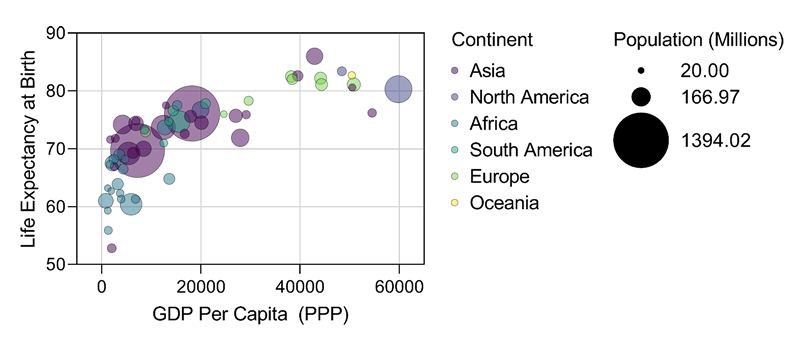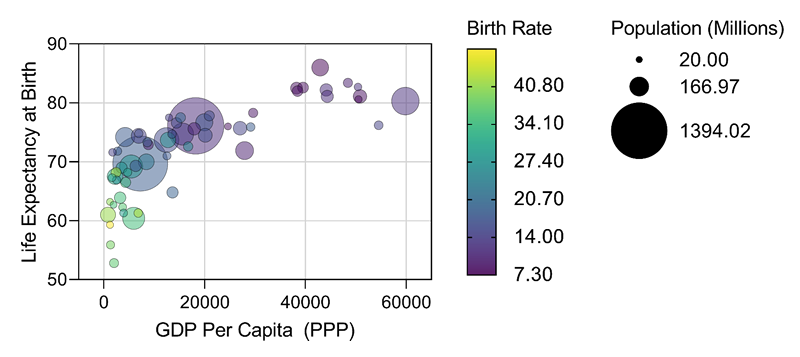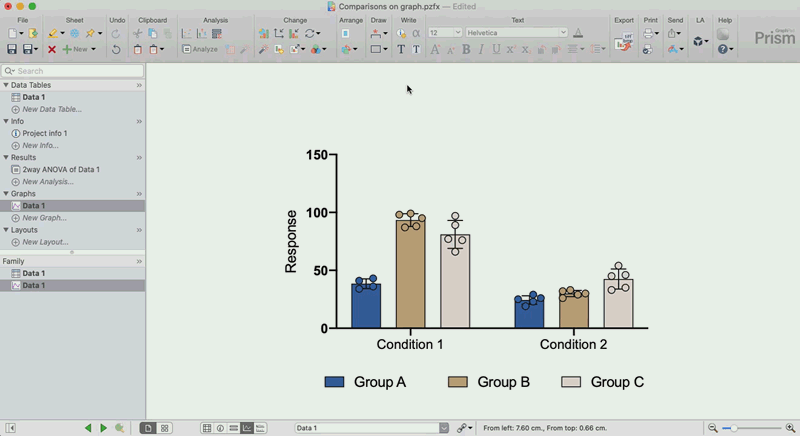探索Prism 9的新功能!
更高维度的数据!
Prism 9 对多变量数据表进行了许多重大改进。使用标准结构探索更大的数据集,并通过以下改进执行新的和改进的分析:
- 增加数据限制 - 在每个数据表中输入多达 1024 列数据
- 自动识别变量类型 - 将多变量数据表中的变量识别为连续、分类或标签值
- 数据表中的文本信息 - 直接以文本形式输入数据。不用编码像“0”和“1”这样的变量,只需在数据表中直接输入“男性”和“女性”
- 自动变量编码 - 输入您的数据,让 Prism 负责其余的工作。Prism 会自动将分类文本变量编码为数字“虚拟”变量
在研究中,我们经常发现自己拥有大量来自实验的不同变量的信息。举个简单的例子,想象一下在给他们服用旨在降低血压的实验药物或安慰剂后测量个体的血压。很可能除了记录的血压测量值之外,您还记录了有关每个受试者的年龄、身高、体重、性别、种族和许多其他潜在变量的大量信息。
许多统计技术旨在分析这种“多变量”数据,例如多元线性回归和多元逻辑回归。使用这些类型的“多变量”分析意味着您可以探索感兴趣的结果,而不会浪费任何潜在的有用信息。为了促进数据信息密度的增加,Prism 提供了我们的多变量数据表,以标准数据结构存储数据,该结构几乎被其他统计软件和软件包(如 R、SPSS 和 MATLAB)普遍使用。在这种格式中,每一列代表一个不同的变量,而每一行代表一个不同的主题(每个主题的每个变量的测量值都放在该主题行的相应列中)。
主成分分析 (PCA)
有时,收集的变量数量远远超过可供研究的受试者数量。考虑基因表达研究,其中从分为两组的受试者测量数百或数千种不同基因的表达水平:治疗组和对照组。可能有太多变量无法将模型拟合到数据中。但是选择一些变量从分析中排除只是丢弃了可能有用的信息!PCA 是一种“降维”技术,可用于减少所需变量的数量,同时从数据中消除尽可能少的信息。
PCA 中可用的其他功能包括:
- 通过并行分析选择成分(以及 Kaiser 方法、总方差阈值方法等)
- 碎石图、分数图和双图的生成
- 自动准备 PCA 结果以进一步用于多元线性回归(主成分回归)
向图表添加新维度
直接从原始数据创建气泡图,编码符号位置(X 和 Y 坐标)、大小和填充颜色的变量。请注意,符号颜色和符号大小都可以使用分类(分组)或连续变量来定义。
在此图表上,100 多个国家/地区显示为单独的圆圈。每个圆圈的 X 坐标代表该国的 GDP (PPP),而 Y 坐标代表出生时的平均预期寿命。每个符号的大小与其所代表的国家的人口成正比(两个最大的符号分别代表中国和印度)。最后,每个符号的颜色代表该国所在的大陆。在这种情况下,这个最终变量(颜色)是一个分类变量,但气泡图中的颜色也可以由连续变量定义:
在该图中,符号的 X 坐标、Y 坐标和大小与之前相同。然而,现在符号的颜色代表了该国每 1000 人的出生率连续比例。Prism 现在还内置了半透明配色方案,以便可以更清楚地看到重叠的符号。
自动将多重比较结果添加到图表中!
只需通过多个成对比较执行适当的分析。然后单击一次以自动将这些结果添加到图表中。要自定义这些行和星号,只需再次单击工具栏按钮。对数据或分析进行调整,图表上显示的结果将自动更新。但请记住,P 值只是故事的一部分。不要忘记报告效果估计值(例如,95% 置信区间的平均差异!)。
使用估计图更好地可视化 T 检验结果
在测试中执行,Prism 现在将自动创建结果的估计图。在此图上,来自两组的原始数据将绘制在左侧 Y 轴上。在右侧 Y 轴上,将绘制组均值的差异及其 95% 置信区间。这种可视化提供了比单独的 P 值更多的信息,因为它除了显示 95% CI 是否包含零外,还显示了 95% CI 的宽度(如果 95% CI 包含零,则 P 值将大于 0.05;如果 95% CI 不包括零,则 P 值将小于 0.05)
Prism 9.3.1 发行说明
Prism 9.3.1 于 2021 年 12 月 16 日发布。
分析错误修复
- 修复了 Prism 错误地报告阈值 alpha/2 的置信区间而不是来自单因子 ANOVA 分析的 Dunnett 的 T3 多重比较测试的全族 alpha 阈值的问题(更多详细信息在此处)
- 修复了如果事件变量包含多个值且下拉菜单选项“将其他值视为”设置为“缺失”,则 Cox 回归分析的“预测”结果表显示为空(而不是插值结果)的问题
- 修复了将空列插入源数据表后,选择的分类变量从 Cox 回归分析参数对话框的“残差”和“图表”选项卡中消失的问题
- 修复了如果源数据表包含空列,则无法在 Cox 回归分析参数对话框的“图表”选项卡中选择分类变量的问题
- (Win) 修复了在 Prism 文档中创建了多个数据表和结果表后,Log-minus-log (LML) 生存图变量未反映在 Cox 回归分析参数对话框的相应下拉列表中的问题
- (Win) 修复了 Cox 回归生成的图表在排除响应/结果变量并重新包含在源数据表中而不查看结果表后显示为空的问题
- (Mac) 修复了如果项目包含大量具有大量数据的数据表并为每个数据表执行相应的 Cox 回归分析,更改“时间”变量后 Cox 回归结果出现错误的问题
其他错误修复
- 修复了如果源数据表中的数据集具有空白或排除值并且“空白/空白”的间距在“格式图表”对话框中设置为 0%,则条形意外叠加而不是分开的问题
- 修复了将 X 和 Y 轴设置为分段时 Prism 会崩溃的问题,其中连接线放置在 Y 轴的两段之间的分割点处
- (Win) 可以将 Prism 图表从一个布局表复制到另一个布局表
- (Win) 修复了将“英寸”更改为“厘米”或反之亦然后图表上的网格线没有更新的问题
- (Win) 修复 UI 刷新问题,在移动“家族”部分的水平分隔符后,控件从导航器的“搜索”部分消失
- (Win) 修复多变量图表的格式图对话框的“最小符号大小”和“大小”下拉菜单中选择值出现“10”而不是“9”的问题
- (Mac) 修复保存并重新打开 Prism 文档时,在“格式配对比较”对话框的“外观”选项卡中输入的自定义 P 值阈值丢失的问题
- (Mac) 修复了启用填充模式后导致“饼图”和“10 x 10 点图”图表上出现意外伪影(显示为网格线)的图形渲染问题
- (Mac) 修复了如果值为“2”、“4”或“9”,则在多个变量图的“格式图”对话框的“最小符号的大小”下拉菜单中,错误值显示为选定值的问题已被选中
Complete release notes for Prism 9.0.0
New Features
- Principal Component Analysis (PCA), a method used to project data in higher dimensional space into a lower dimensional space by maximizing the variance of each new dimension. PCA is mostly used as a tool in exploratory data analysis and for making predictive models. It is often used to visualize genetic distance and relatedness between populations.
- New graph types generated by PCA
- Scree plots. Scree plots are used to visualize raw eigenvalues for each principal component (PC) identified in principal component analysis (PCA).
- Score plots. Score plots provide a means of viewing the original data in the new (reduced) dimensional space of two indicated PCs (typically PC1 as the horizontal axis and PC2 as the vertical axis).
- Loading plots. Loading plots provide a means to visualize the coefficients for two selected principal components.
- Biplots. Biplots are combinations of score plots and loading plots.
- Proportion of variance plots. This graph is similar to the Scree Plot described above, but is used with a slightly different interpretation style.
- Multiple variables graphs to graph data from the Multiple variables data table
- Make a Bubble Plot, where symbol size is encoded by a numerical or categorical variable.
- Encode symbol color and the appearance of connecting lines with other variables.
- All these choices are made on a brand new Format Graph dialog with an improved appearance.
- New semi-transparent color schemes for bubble plots.
- Estimation Plots which are a visual way to present the results of two-sample comparison tests such as the t test. The purpose of this graph which contains raw data as well as a summary of the analysis result is to emphasize the importance of effect sizes and confidence intervals while simultaneously de-emphasizing the concept of “significance”.
- Pairwise comparisons on graphs which is an automatic generation of visualizations that combine user data with results of pairwise comparisons made during hypothesis tests (i.e. automatically adding significance stars to graphs).
Feature Improvements
Nonlinear regression
- Dramatically improved performance and accuracy of evaluating user-defined equations
- Define X0 for differential equations like any other parameter
- Create five residual graphs (including the new Actual vs Predicted graph). Previously, only one graph per analysis could be generated
- Re-arranged and re-labeled the options for "Unstable parameter and ambiguous fits" section on the Confidence tab of the NLR parameters dialog.
Multiple linear/logistic regression analyses
- Choose models with categorical independent variables with automatic reference level specification
- Specify method for "automatic" reference level specification based on data (first or last level, most or least frequent level)
- Specify the order of categorical variable level results via the "Define categories order" options from the Reference level tab of the MLR parameters dialog
- Improved model control (tree view) for better presentation of categorical variables and interactions
- Simplified model representation in the dialog
- Interpolate values for the outcome (dependent) variable using data in the data table or specified values for each predictor in the parameters dialog (multiple linear regression only)
- Improved Correlation matrix output so a heatmap of the results can be generated
Multiple two sample tests analysis (Multiple t test analysis) now includes options for:
- Multiple unpaired t-tests with Welch correction
- Multiple paired t-tests
- Multiple ratio-paired t-tests
- Multiple nonparametric unpaired Mann-Whitney tests
- Multiple nonparametric paired Wilcoxon tests
- Multiple nonparametric unpaired Kolmogorov-Smirnov tests
Row statistics analysis
- Allows for calculation of mean with custom confidence interval level
- Allows for calculation of medians with "no errors", "quartiles", "min / max", "percentiles"
- Allows for calculation of geometric means with "no errors", "geometric SD", “CI”
Two-way ANOVA: main effects only model
- Allow for main effects only model (no interaction term) in two-way ANOVA for data with replicates
- Allow missing factors levels combination in two-way ANOVA for main effects only model
- "Simple effects" multiple comparisons not allowed for unreplicated two-way ANOVA
Made the default title of standard transform with linked parameter be generated using analysis constant name instead of a value.
Changed the default to the choice for unstable in 'Confidence' tab of 'Parameters: Nonlinear Regression' dialog.
Updated the behavior of analyses that can be performed on multivariable tables to properly handle different variable types
When creating a correlation matrix, choose to ignore rows where any value is missing or excluded. With this option selected, all correlation coefficients in the matrix computed from the same set of rows
Allowed 'Select and Transform' analysis to define types for variables in green multiple variables results table
(Mac) Added the alert "You are trying to analyze a single column. If you wish to perform a one-sample t test, use the One sample t and Wilcoxon test analysis. A t test requires two groups (both in Y columns; the X column is ignored)"
Non-math feature improvements
New data limits
- Lifted data table limits of 1024 data sets [letters A...AMJ] and 512 sub-columns.
- Lifted graph limits to be able to plot 1024 data sets.
Multiple variable data tables
- Enabled the support of text variables in Prism's multiple variables data tables.
- Implemented the ability to define variable types in Prism's multiple variables data tables
Special symbols and Unicode
- Added the “Character>Unicode Symbols...” command in the Insert main menu, which will open the standard system "Character Map" dialog and allow entering a bigger variety of special symbols.
- (Windows) Upgraded Prism's "Insert Character Dialog" and replace the legacy approach of using Symbols font for Greeks/Maths/European characters with Unicode compatible characters, thus, allow seamless compatibility across platforms and 3rd party apps.
Added the Export command to the contextual menu opened in the Navigator when right-clicking on any sheet type, including graphs and layouts.
Made Prism also delete graphs if you delete parent analysis which generated those graphs, but doesn't delete graphs when an analysis adds a curve to an existing graph of data.
Changed the command “Choose Color Scheme…” in the main Change menu to “Color Scheme>” and made it open the submenu showing the same content except for Background, Plotting area, Axes for 'Bubble Plot' graphs.
Added the new section with semi-transparent color schemes to 'Change -> Color Scheme' and 'Change colors' toolbar's dropdown menus.
Formatting of graphs or data points on graphs from a data table and results
- (Windows) Made it possible to apply Bar, Error Bar and Line options using the Format Points contextual menu from a data table to the scatter with bars grouped graphs.
- (Windows) Made it possible to apply Error Bar and Line options using the Format Points contextual menu from a data table to scatter grouped graphs.
- (Windows) Made it possible to apply Line and Quartile formatting using the Format Points contextual menu from a data table to Violin graphs.
- (Windows) Made it possible to apply Error Bar and Line options using the Format Points contextual menu from a data sheet for superimposed Scatter graphs.
- (Windows) Made it possible to format data points on a graph from the green results tables. Case 1056514.
- (Windows) Enabled the formatting of selected symbols on a violin graph from the Format Points contextual menus on a data table.
- (Windows) Enabled the formatting contextual menu for a violin in the "Violin plot only" graph with reverse direction
- (Mac) Enabled the Line section in the Format Points contextual menus to be able to format data points on graphs with means and medians from the data table
Updated URLs in floating notes of sample data files from the Welcome dialog to point to the Prism 9 User guide (instead of an earlier version of the guides)
(Windows) Prism can now import "True" or "False" boolean values from excel as "1" and "0" into Prism's multiple variables data tables
(Windows) Made Prism show all sheets from the family in the 'Delete Sheet(s)' dialog opened in the family navigator panel
(Windows) Updated system requirements to Windows 7. Added the alert about urging to update Windows when Prism starts on Vista
(Mac) Removed the "Y" label on top of each individual column in Column/Grouped/Contingency/Multiple Variable/Parts of Whole data tables
(Mac) Made Prism remember the size of the last used window, and use that as the default size for new windows
(Mac) Enabled the 'Reverse Category Order' command in the 'Change' and context menus for Parts of Whole graphs
(Mac) Renamed the 'Reverse Data Set Order' command to 'Reverse Category Order' in the 'Change' and context menus for Parts of Whole graphs
Performance Improvements
- Improved the performance of the 'Correlation matrix' analysis more than 20x
- (Windows) Improved the performance of the Fit spline/LOWESS analysis with residual calculations by ~10x
- (Windows) Improved the performance of the 'Simple logistic regression' analysis more than 1.5x
- (Windows) Improved the performance of the 'Transform' analysis by ~4x
- (Windows) Improved the performance of the 'Prune rows' analysis by ~3x
- (Windows) Improved the performance of simulating XY data with a large number of values and several replicates more than 10x
- (Windows) Improved the performance of switching to a Grouped graph sheet when the source data contains a large number of rows more than 3x
- (Windows) Improved the performance of the 'Normalize' analysis slightly
- (Windows) Improved the performance of the 'Monte-Carlo' analysis when the source data table contains data linked from other analyses by several times
- (Mac) Improved the performance of the 'Transform' analysis by ~2.5x
- (Mac) Improved the performance of the 'Prune rows' analysis more than 10x
- (Mac) Improved the performance of switching to a Grouped graph sheet when the source data contains a large number of rows more than 2x
- (Mac) Improved the performance of the 'Normalize' analysis more than 5x
Infrastructure
- (Windows) Prism 9 is only available for 64-bit Windows. There is no 32-bit version of Prism for Windows
- (Mac) Prism 9 requires macOS 10.12 (Sierra) or newer
Analysis bugs fixed
- Fixed crash on performing Extract and rearrange analysis with t-test mode for large data.
- Fixed crash on attempt to perform custom equation analysis with particular inappropriate syntax.
- Fixed the issue where the wrong column letters were displayed in the "Data sets analyzed" row of the one-way ANOVA results sheet if not all datasets were analyzed
- (Windows) Fixed the issue in which a blank results sheet was displayed for the "Plot a function" analysis after unchecking the "Plot the first derivative" option
Graphing bugs fixed
- Fixed the issue when a pattern fill applied to all data sets appeared missing from some bars on a bar graph
- Fixed the issue when color settings were not applied to the graph if ‘All’ item was selected in the ‘Data Sets’ section of the ‘Define Color Scheme’ dialog
- Fixed the issue when some data points were outside the axis limits on the Grouped scatter plot graph if the source data table contained a large number of rows.
- Fixed the issue when the ‘Median’ was unexpectedly changed to ‘Mean’ in the ‘Style’ section of the ‘Format Graph’ dialog after selecting the ‘Scatter dot plot’ or the ‘Aligned dot plot’ appearance.
- Fixed the issue when the excluded property of X values appeared lost after cloning graph and changing data table format to show error values.
- Fixed the issue when it was impossible to format data points on XY graphs using the Format Points contextual menu on a data table after executing the "Apply Data Set Format" contextual command.
- (Windows) Fixed the issue that when you try to format a single violin on a graph, it unexpectedly changes all violins of the entire data set.
- (Windows) Fixed the issue when row titles were corrupted on a grouped graph after adding new data and clicking on the X axis if bars could not be displayed.
- (Windows) Fixed the issue when a graph disappeared from the sheet after performing the 'Group' command for two drawing brackets with asterisks.
- (Windows) Fixed the issue when shading between custom axis lines was lost after another shading was added to the graph
- (Windows) Fixed the issue in which points on the resulting graph did not retain the color formatting when the graph family had been duplicated
- (Mac) Fixed the issue in which bars on an interleaved graph overlapped if the value fo the second bar was set to zero
Other bug fixes
- Fixed the issue when 'Set as Default' option in the 'Format Object' dialog did not work for text objects.
- Fixed the issue when 'Plot' drop-down and 'Show truncated violin plot' checkbox were unexpectedly shown in the Change Graph Type dialog for grouped or nested violins if one data set has been plotted with showing points.
- Use Šídák instead of Sidak in Parameters analysis dialogs and results.
- (Windows) Fixed that crash that occurred after invoking Format Axes for graph after canceling Magic Step 2.
- (Windows) Fixed the crash when changing the graph's appearance in the Format Graph dialog globally for odd data sets.
- (Windows) Fixed the crash on attempt to rename multiple sheets in the gallery view of a Navigator's Family Pane which were deleted and restored using for analyses with residual graphs
- (Windows) Fixed the crash on changing Scatter to Violin plot graph if several data sets in a data table were replaced by a single data set beforehand.
Fixed the crash on making a number of subcolumns huge (over 178 for Prism 8, over 238 for Prism 9) for a data set containing a huge number of values in a data table (~500000).
- (Windows) Fixed the issue when all subcolumns became filled with values on making the number of subcolumns large if any data set contained a huge number of values.
- (Windows) Fixed the issue when the unexpected alert appeared on changing replicates number for data table with a huge number of subcolumns and rows.
- (Windows) Fixed the issue when warning did not appear on inserting data that exceeded the maximum number of supported columns.
Fixed the issue when values were not added and unexpected alert appeared on an attempt to add a huge number of values into the data table with a lot of subcolumns.
- (Windows) Fixed the issue when only the first row of the multi-line row title appeared visible after deleting another row in the data table.
- (Windows) Fixed the issue when it was impossible to format data points from results table.
- (Windows) Fixed the issue when controls were not aligned in the upper left of the Welcome dialog when stretched it.
- (Windows) Fixed the issue when unexpected characters were shown next to the data-set title containing numbers in the 'Hint' section of the 'Replace Data Set' dialog.
- (Windows) Fixed the issue when the 'Reverse Legends Order' command was unexpectedly available when there were one or no legends on a graph.
- (Windows) Fixed the issue when the error bars section in Format Points contextual menu on a data table was not dimmed when there were no error bars on a graph.
- (Windows) Fixed the issue when a part of the data table was not visible after navigating to the bottom of a data set via then End key with a huge number of values.
- (Windows) Fixed the issue in which Prism would crash after selecting undo for actions done in Info Notes and Info Table
- (Mac) Fixed the issue in which Prism would freeze on an attempt to switch to a simulated XY data sheet with 256 data sets and 256 replicates
- (Mac) Fixed the issue in which it was impossible to create or open a PRism file with a large amount of data (256 data sets, 256 replicates, 500 rows)
- (Mac) Fixed the broken "Also draw lines" drop-down for line thinkcness in the "Gaps" tab of the "Format Graph" dialog for heatmaps
- (Mac) Fixed the issue in which the yellow color was missing from the "Highlight selected cell" icon on the toolbar
在线留言
尊敬的客户朋友,如您有任何意见建议,请通过下表反馈给我们,我们会尽快与您联系。
|





